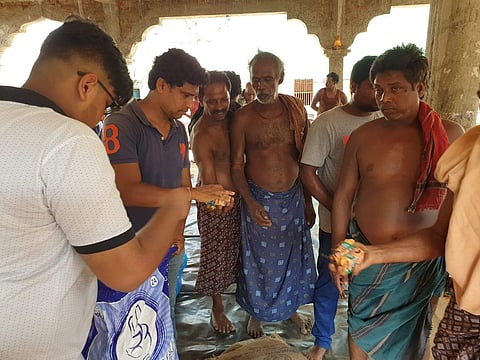
- News
- Campus
- Exam
- Podcast
- Web Stories
- Do You Know
- Path Finders - UG Programs
- Videos
- Book Review

There's nothing like death to confront us with the ugly truth of life. So as a Class VIII student, when Naisargik Lenka visited a village to attend a relative's funeral, it was all kinds of devastating. "Having cancer in that area was like having a cough or cold, most people were not even aware they were suffering from it," rues the 18-year-old. The area he is referring to is Sukinda Valley, in the Jajpur district of Odisha where chromite (an ore of chromium) mining activities are rampant and as a result, so is the dreaded disease. The overburden (ecosystem that lies above a coal seam) would seep into underground water bodies and bore wells, which forced the inhabitants to walk for several kilometres to access clean water. 'What can be done about this?' Naisargik asked himself.
As a student, Naisargik has always been inclined towards research. In Class VI, he developed an automatic pay toilet system which was adopted, further enhanced and implemented by the Bhubaneswar Municipal Corporation (BMC). So this time, he started reaching out to many researchers in a quest to tackle the problem and heard back from one, Dr Sailabala Padhi, Director, Centre for Environmental Studies. "She not only encouraged me but taught me everything that I know about understanding research papers and methodologies," says the youngster who will be heading to Johns Hopkins University in the US, to pursue Biomedical Engineering this August. But after she retired, he was at sea again until Dr Kishore Panigrahi from the National Institute of Science Education and Research (NISER) who guided him further.
But what was this solution he was working on? A polymer matrix, when added to the soil after ploughing, has the ability to restrict carcinogenic substances like chromium from entering into water bodies. Plus, the algae inside this matrix absorbs all the chromium that is already present in water. The best way to describe this matrix is that it looks like a gel and has a particular algae, which Naisargik is not too keen to reveal, that will help the cause. Currently, the Government of Odisha's Agricultural Ministry has taken over the reins of this project and is testing it. If all goes well, it might be implemented across the valley.
Additionally, what this Ashoka Fellow did is co-founded Yuva Utkal, a youth-led civic action group in 2018. They started interacting with residents and children who are most affected by this travesty and are trying to spread awareness, apart from conducting field trials and hearing first-hand, the ill effects of mining. "It was difficult for them to trust us, so through mutual friends, we found one well-respected man from the valley and with his help, interacted with the villagers," explains Naisargik and once they started talking, it was like Pandora's box had been unlatched. Malnourished children, women walking for nine kilometres for fresh water every day, development of children being affected — it was pandemonium all around. This is why the Rourkela-born's idea is even more important.
Now that, very soon, Naisargik will be off to a new country, he says that he fully intends to come back and focus on the problems of his people. "I want to work in the field of Medicine, so that I can help people back in the valley," he shares and concludes.
